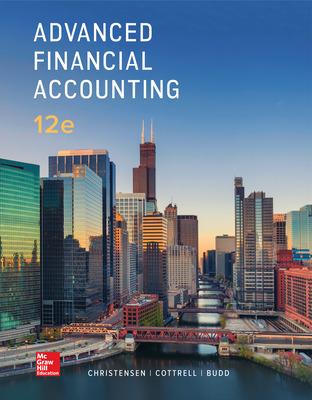Question
A company is seeking to invest in a new line of business costing $10M over a planning horizon of 10-year timeframe. The following table lists
A company is seeking to invest in a new line of business costing $10M over a planning horizon of 10-year timeframe. The following table lists the essential data for you to compute the after tax weighted average cost of capital assuming a marginal tax rate of 30%
| Weighted Cost of Capital (After Tax) | After Tax. | Ignore Flotat. Cost |
| Tax Rate = 30% |
|
| CAPITAL REQUIRED $10M OVER 10-YEAR PERIOD |
|
|
|
|
|
|
|
| Weights | Cost % | BT Weighted Cost | AT Weighted Cost |
| Financing | $M Value | $Value/Total | See Class Notes | Columns 3x4 | |
| debt $1,000 Face Value | 5.00 |
|
| * |
|
| preferred stock | 1.00 |
|
|
|
|
| new common stock | 3.00 |
|
|
|
|
| retained earnings | 1.00 | ____ |
| _____ | _____ |
| TOTAL | Total |
|
|
| |
| * See Excel bond Exp. Return = Yield to M. |
|
|
|
|
Assumptions:
1. $1,000 bond selling for $1,040 paying 12%
- Preferred stock selling for $16.50 paying $1.00
- Common stock will pay $2.00 selling for 50.00 with a growth rate (g) = 4.0%
Based on the information above answer the following questions. and show the process as best you can and explain what the % means in terms of capital budgeting decisions
a. What will be the before tax weighted average cost of capital? ____ %
b. What will be the after tax weighted average cost of capital ? _____ %
c. Explain the importance of the weighted average cost of capital after tax to the business for decision making.
A company is seeking to invest in a new line of business costing $10M over a planning horizon of 10-year timeframe. The following table lists the essential data for you to compute the after tax weighted average cost of capital assuming a marginal tax rate of 30%
| Weighted Cost of Capital (After Tax) | After Tax. | Ignore Flotat. Cost |
| Tax Rate = 30% |
|
| CAPITAL REQUIRED $10M OVER 10-YEAR PERIOD |
|
|
|
|
|
|
|
| Weights | Cost % | BT Weighted Cost | AT Weighted Cost |
| Financing | $M Value | $Value/Total | See Class Notes | Columns 3x4 | |
| debt $1,000 Face Value | 5.00 |
|
| * |
|
| preferred stock | 1.00 |
|
|
|
|
| new common stock | 3.00 |
|
|
|
|
| retained earnings | 1.00 | ____ |
| _____ | _____ |
| TOTAL | Total |
|
|
| |
| * See Excel bond Exp. Return = Yield to M. |
|
|
|
|
Assumptions:
1. $1,000 bond selling for $1,040 paying 12%
- Preferred stock selling for $16.50 paying $1.00
- Common stock will pay $2.00 selling for 50.00 with a growth rate (g) = 4.0%
Based on the information above answer the following questions. and show the process as best you can and explain what the % means in terms of capital budgeting decisions
a. What will be the before tax weighted average cost of capital? ____ %
b. What will be the after tax weighted average cost of capital ? _____ %
c. Explain the importance of the weighted average cost of capital after tax to the business for decision making.
A company is seeking to invest in a new line of business costing $10M over a planning horizon of 10-year timeframe. The following table lists the essential data for you to compute the after tax weighted average cost of capital assuming a marginal tax rate of 30%
| Weighted Cost of Capital (After Tax) | After Tax. | Ignore Flotat. Cost |
| Tax Rate = 30% |
|
| CAPITAL REQUIRED $10M OVER 10-YEAR PERIOD |
|
|
|
|
|
|
|
| Weights | Cost % | BT Weighted Cost | AT Weighted Cost |
| Financing | $M Value | $Value/Total | See Class Notes | Columns 3x4 | |
| debt $1,000 Face Value | 5.00 |
|
| * |
|
| preferred stock | 1.00 |
|
|
|
|
| new common stock | 3.00 |
|
|
|
|
| retained earnings | 1.00 | ____ |
| _____ | _____ |
| TOTAL | Total |
|
|
| |
| * See Excel bond Exp. Return = Yield to M. |
|
|
|
|
Assumptions:
1. $1,000 bond selling for $1,040 paying 12%
- Preferred stock selling for $16.50 paying $1.00
- Common stock will pay $2.00 selling for 50.00 with a growth rate (g) = 4.0%
Based on the information above answer the following questions. and show the process as best you can and explain what the % means in terms of capital budgeting decisions
a. What will be the before tax weighted average cost of capital? ____ %
b. What will be the after tax weighted average cost of capital ? _____ %
c. Explain the importance of the weighted average cost of capital after tax to the business for decision making.
Step by Step Solution
There are 3 Steps involved in it
Step: 1

Get Instant Access to Expert-Tailored Solutions
See step-by-step solutions with expert insights and AI powered tools for academic success
Step: 2

Step: 3

Ace Your Homework with AI
Get the answers you need in no time with our AI-driven, step-by-step assistance
Get Started


